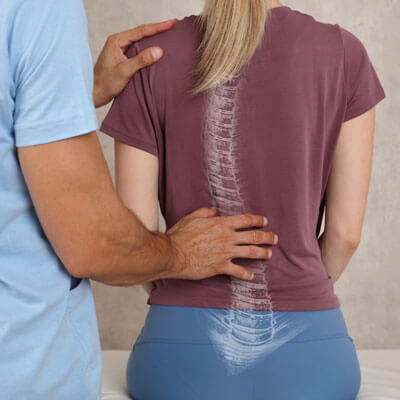Scoliosis Treatment in Jersey
 Considered an abnormal sideways curvature of the spine, scoliosis begins as a postural distortion. If scoliosis is left untreated, it could become a permanent deformity.
Considered an abnormal sideways curvature of the spine, scoliosis begins as a postural distortion. If scoliosis is left untreated, it could become a permanent deformity.
There are three causes of scoliosis:
- congenital (genetic predisposition)
- habitual (behavioural routines)
- idiopathic (unknown cause)
Are There Obvious Clues?
A parent may notice that their child has a high shoulder or low hip that makes clothing fit poorly. Uneven shoe wear also may provide a clue. Children with scoliosis also may experience back and leg pains, but these are usually dismissed as ‘growing pains.’
Wait and See?
Scoliosis may often worsen if left to just ‘run its course.’ In severe cases, a child may need to wear an unsightly or cumbersome brace or have surgery that attaches steel rods, forcing the spine to straighten.
Natural Approach
Chiropractic adjustments may help to improve the spine’s structure and function. Because an adjustment also may help strengthen and retrain muscles, your child’s posture may improve.
If you think your child may have scoliosis, we recommend that you bring them in so our experienced The Wellness Centre (Castle Quay) chiropractors can provide an evaluation and determine if we think we can help.
Frequently Asked Questions
Isn’t a certain amount of sideways curvature considered normal?
When does scoliosis require care?
Do heavy backpacks cause scoliosis?
What types of techniques do you find successful for improving scoliosis?
How long until patients typically notice relief?
How quickly a patient notices an improvement in their condition depends on the presenting symptoms, the age of the patient, and the type and severity of the scoliosis. It is important to remember that structural scoliosis can be well managed and its speed of degeneration reduced; however, it cannot be fully removed. Functional scoliosis will usually resolve as the underlying cause is treated.
Do you welcome children and adults for scoliosis care?
Patients of all ages are welcome to our centre.
Patient Success Story
Miss B, an 18-year-old student, presented to the centre with upper back pain, headaches and concern over her poor posture. Her assigned chiropractor conducted a full health history, a full orthopaedic examination and a posture screen.
From these examinations, it was evident that Miss B was suffering from biomechanical dysfunction of her mid-back and neck, causing excess pressure on the surrounding muscles and nerves, ultimately leading to the symptoms of back pain and headaches. The examination also revealed that Miss B had a mild, full spine scoliosis (side curvature of the spine) which was likely contributing to some of the biomechanical dysfunctions noted.
Miss B was recommended for a course of care consisting of chiropractic spinal manipulation, muscle relaxation, soft tissue techniques and an exercise-based postural rehabilitation program. It was also explained to Miss B that the scoliosis had likely been present since her early years and that the care program proposed would help to improve her posture but would not take away the scoliosis. However, well-balanced back and core muscles, together with a healthy spine, would help to minimise scoliosis over the years.
As Miss B embarked on the suggested postural correction/rehabilitation program, she soon noticed a marked reduction in her back pain and a full resolution of her headaches. She also felt stronger and had more energy than before her care began. As Miss B progressed in her recovery, she started to implement her postural exercises into her day-to-day life and into her weekly exercise plan, enabling her to take control of her own future good posture.
Find Out More Today
Contact us today to learn more about how chiropractic care can be part of an overall program to manage your scoliosis.

